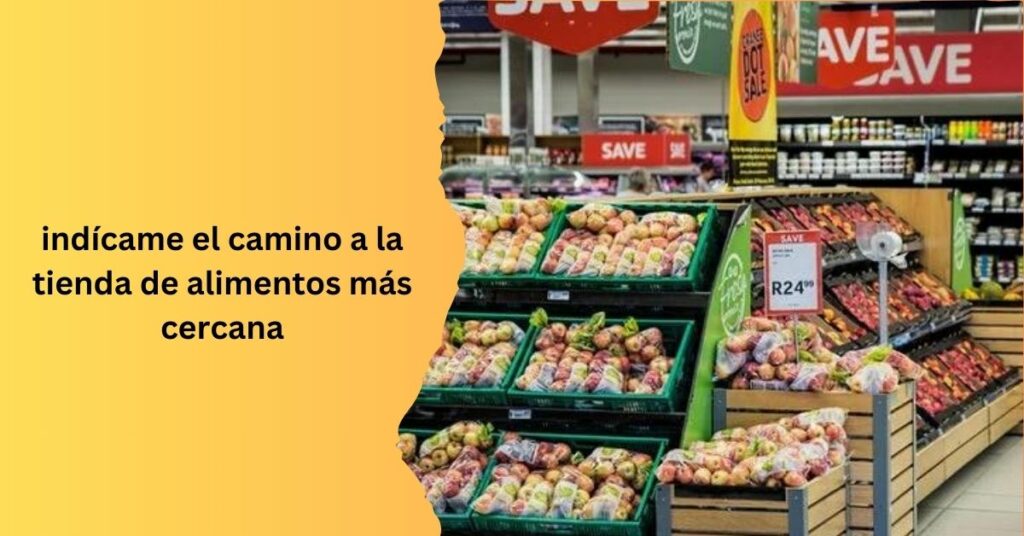indícame el camino a la tienda de alimentos más cercana

In the hustle and bustle of our daily lives, the need to find the nearest grocery store quickly and efficiently is a common occurrence. Whether you’re a local resident or a visitor in a new area, knowing how to navigate your way to the closest food haven is essential.
In this comprehensive guide, we will explore various methods and tools that can help you find the most convenient route to your nearest grocery store.
Utilizing Online Maps and Navigation Apps:
In this section, we delve into the convenience offered by online maps and navigation applications in our quest to find the nearest grocery store. With the likes of Google Maps, Apple Maps, and Waze, individuals can effortlessly locate nearby grocery options, obtain real-time directions, and make informed decisions about the most efficient routes.
These technological tools have become indispensable for their user-friendly interfaces and features such as turn-by-turn navigation, making them the go-to solution for those seeking a seamless and tech-savvy approach to finding their way to the grocery store.
Exploring Location-Based Services:
This section explores how location-based services play a pivotal role in the search for the nearest grocery store. Platforms like Yelp and Yellow Pages, equipped with GPS capabilities, allow users to conduct location-specific searches and generate comprehensive lists of nearby grocery stores.
Social media platforms, too, have evolved into valuable resources, enabling users to leverage location-based hashtags and recommendations to discover local businesses.
By examining reviews and ratings, individuals can make well-informed decisions about which grocery store to visit, harnessing the power of technology to enhance their overall shopping experience.
Traditional Methods and Local Knowledge:
Despite the prevalence of technology, this section underscores the enduring value of traditional methods and local knowledge when searching for the nearest grocery store. Engaging with the local community, whether through conversations with neighbors, passersby, or business owners, provides a unique and enriching perspective.
Additionally, exploring neighborhood directories, often available in community centers or online forums, offers a more grassroots approach to finding grocery stores.
By combining technology with insights from local residents, individuals can tap into a wealth of information that might not be readily available through digital means alone.
Navigating on Foot or Public Transportation:
This section focuses on the practical aspects of navigating to the nearest grocery store on foot or using public transportation. For urban dwellers, walking to the grocery store can be both a healthy and sustainable option.
Online maps with pedestrian navigation features guide individuals through pedestrian-friendly routes, highlighting sidewalks and crosswalks. Understanding and utilizing public transportation options is crucial for those who rely on buses, trains, or other transit modes.
This section emphasizes the importance of incorporating these eco-friendly and community-oriented approaches into the journey to the grocery store.
Additional Considerations and Tips:
The concluding section provides practical tips and considerations to ensure a smooth and stress-free experience when heading to the grocery store. Checking store hours, confirming special services, being mindful of parking, and considering delivery options are highlighted as key elements in the planning process.
These additional considerations are designed to enhance the overall shopping experience, whether one is driving, walking, or utilizing public transportation. By paying attention to these details, individuals can make their grocery trips more efficient and tailored to their specific needs.
Embracing Digital Grocery Shopping:
This heading delves into the growing trend of digital grocery shopping and how individuals can leverage online platforms and apps to order groceries from the comfort of their homes. From exploring various online grocery delivery services to understanding the benefits and potential drawbacks, this section provides insights into the evolving landscape of grocery shopping in the digital age.
Navigating Neighborhood Markets:
Highlighting the charm of local neighborhood markets, this section explores the experience of discovering smaller, community-centric grocery stores. From corner markets to specialty stores, individuals can uncover hidden gems within their neighborhood, fostering a sense of community and supporting local businesses. The section emphasizes the unique products and personalized services often found in these smaller establishments.
Sustainable Grocery Shopping Practices:
In this environmentally conscious era, this section explores sustainable practices related to grocery shopping. From choosing eco-friendly products to minimizing packaging waste, individuals can make informed choices that align with their commitment to sustainability. The section also touches on how some grocery stores prioritize environmental initiatives, providing shoppers with options that contribute to a greener lifestyle.
Culinary Exploration: Ethnic Grocery Stores and International Markets:
This heading delves into the adventure of exploring ethnic grocery stores and international markets. Individuals can broaden their culinary horizons by discovering a diverse array of ingredients and products from around the world. From spices and condiments to unique snacks and beverages, this section guides readers on how to navigate and appreciate the rich offerings of these culturally diverse grocery shopping experiences.
Seasonal and Farmers’ Market Expeditions:
Highlighting the significance of seasonal and farmers’ markets, this section encourages individuals to explore the fresh and locally sourced options available during different times of the year.
From understanding the benefits of supporting local farmers to enjoying the unique produce each season brings, this heading guides readers on how to incorporate these markets into their grocery shopping routine, fostering a deeper connection to the agricultural community.
Mindful Budgeting in Grocery Shopping:
This heading delves into the art of mindful budgeting when it comes to grocery shopping. From strategic meal planning to leveraging discounts and loyalty programs, this section provides practical tips on how individuals can optimize their spending while still enjoying a variety of nutritious and flavorful options.
Exploring cost-effective alternatives and making informed choices contribute to a more conscious and budget-friendly grocery shopping experience.
Tech Innovations in Grocery Retail: The Future of Shopping:
This forward-looking heading explores the cutting-edge technologies shaping the future of grocery retail. From cashier-less checkout systems to augmented reality shopping experiences, this section delves into the tech innovations revolutionizing the way people shop for groceries.
By understanding and embracing these advancements, individuals can stay at the forefront of a rapidly evolving retail landscape, enhancing their overall grocery shopping journey with the latest technological conveniences.
Conclusion:
Finding the nearest grocery store is a task that can be approached in various ways, depending on individual preferences and circumstances. Whether you prefer the convenience of technology-driven navigation or the charm of exploring your neighborhood on foot, the key is to leverage the available tools and resources.
By combining modern technology, location-based services, traditional methods, and local knowledge, you can embark on a journey that not only leads you to your desired grocery store but also allows you to discover the unique aspects of your surroundings.







